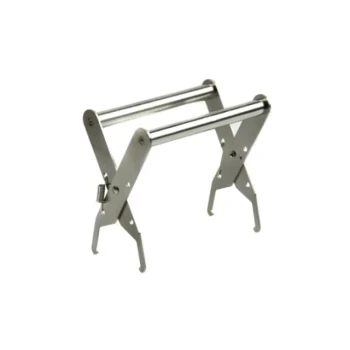Yes, bees will absolutely build comb on empty frames, a practice known as foundationless beekeeping. However, success is not guaranteed and depends entirely on the hive's condition, the season, and especially where you place the frame. Placing an empty frame incorrectly can create significant stress for the colony.
The core issue isn't if bees will build on empty frames, but how to encourage them to do so correctly. Success hinges on providing the right conditions and understanding that you are trading the convenience of pre-made foundation for the benefits of allowing the bees' natural instincts to take over.

Why Bees Will Build on Empty Frames
Bees possess an innate drive to build wax comb for raising brood and storing resources. An empty frame simply provides the space for them to execute this natural behavior.
Tapping into Natural Instincts
Bees build comb by hanging together in chains, a behavior called festooning. An empty, foundationless frame allows them to form a single, efficient festoon across the entire space.
This is their preferred and most energy-efficient method for comb construction.
The Problem with Foundation
Conversely, a frame with foundation installed acts as a barrier. It forces the bees to form two separate, smaller festoons on either side of the sheet.
This process is less efficient, requiring more time and energy from the colony to accomplish the same task.
The Keys to Success: Timing and Placement
Simply adding an empty frame is not enough. Where and when you add it will determine whether the bees use it productively or see it as a dangerous void in their nest.
The Danger of the Brood Nest
The brood area is the nursery of the hive, and bees work tirelessly to maintain its temperature at a constant, stable level.
Placing an empty frame directly in the middle of the brood nest creates a large, cold gap. This destroys the regulated temperature, forcing the bees to expend massive amounts of energy to re-establish it, which causes significant stress on the colony.
The Correct Placement
The best place to add an empty frame is on the outer edges of the brood nest, between the last frame of brood and a frame of food (pollen or honey).
This placement allows the colony to expand naturally into the space when they are ready, without disrupting the critical core temperature of the nest.
Empty Frames vs. Foundation: Understanding the Trade-offs
Choosing between empty frames and those with foundation involves a trade-off between natural comb and beekeeper control. Neither approach is universally superior; the right choice depends on your goals.
The Challenge of Plastic Frames
Bees do not readily accept plastic frames or foundation. Their instincts are geared toward natural beeswax.
For a colony to even consider using plastic, the frames must be thoroughly coated in melted beeswax. Even then, if given a choice, bees will almost always choose to build on natural wax or in an empty space first.
The Benefit of Wax Foundation
Wax foundation serves as a guide, encouraging bees to build straight combs that are easier for the beekeeper to inspect and manage. This is the primary reason for its widespread use.
However, as noted, it interferes with their natural festooning behavior.
Reusing Old Frames
Old frames that previously held comb can be reused. Bees are often attracted to the scent of old wax and propolis, which can encourage them to build.
Be aware that empty stored frames can fall prey to pests like wax moths or mice. Always inspect and clean old equipment before placing it in an active hive.
Choosing the Right Frame Strategy
Your decision should be guided by the specific needs of your hive and your beekeeping philosophy.
- If your primary focus is natural beekeeping: Use empty (foundationless) frames on the edge of the brood nest to allow bees to build comb according to their own instincts.
- If your primary focus is hive management and straight combs: Use frames with wax foundation to guide comb construction for easier inspections and honey extraction.
- If you must use plastic frames: Ensure they are heavily coated with real beeswax to increase the chances of the bees accepting them.
Ultimately, working with bees is about understanding and respecting their natural tendencies to create a productive partnership.
Summary Table:
| Strategy | Best For | Key Consideration |
|---|---|---|
| Empty Frames | Natural beekeeping, promoting natural instincts | Place on the outer edge of the brood nest to avoid temperature stress |
| Wax Foundation | Hive management, straight combs for easy inspection | Guides bees but disrupts their natural festooning behavior |
| Plastic Frames | Durability | Requires heavy coating with real beeswax for bee acceptance |
Equip Your Apiary for Success with HONESTBEE
Whether you're a commercial apiary scaling up operations or a distributor supplying the beekeeping community, the right equipment is crucial for hive health and productivity. HONESTBEE supplies durable, high-quality beekeeping supplies and equipment through wholesale-focused operations.
We provide the tools you need to succeed, from frames and foundations to essential hive components. Let us help you build a stronger, more efficient beekeeping business.
Contact HONESTBEE today to discuss your wholesale needs and discover how our equipment can benefit your operation.
Visual Guide

Related Products
- Heavy-Duty Stainless Steel Frame Grip
- Heavy-Duty Stainless Steel Clip-On Frame Perch
- Heavy-Duty Stainless Steel Frame Perch
- Plastic Bee Frame Beekeeping Hive Frames for Wholesale
- Plastic Honey Comb Frames Cassette Box for Honey
People Also Ask
- How does the frame lifter hive tool function? Master Safe and Gentle Frame Removal
- What is the purpose of a frame grip in beekeeping? Achieve Secure, One-Handed Frame Handling
- How do you use Frame Grips during hive inspections? Achieve Calmer, More Efficient Hive Inspections
- What are Frame Grips used for in beekeeping? Boost Your Hive Inspection Efficiency & Bee Safety
- What are the benefits of using Frame Grips in beekeeping? Boost Efficiency & Protect Your Hive



















